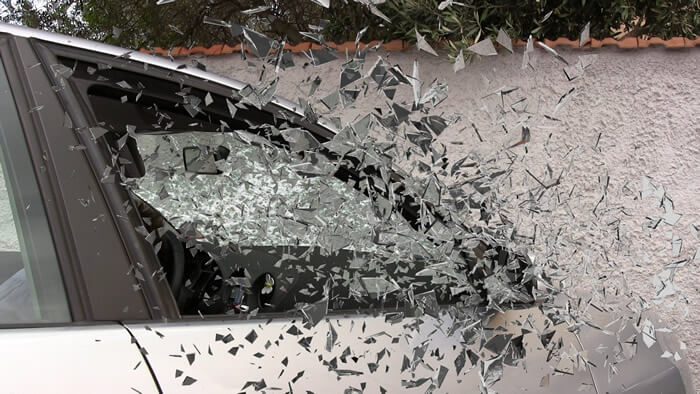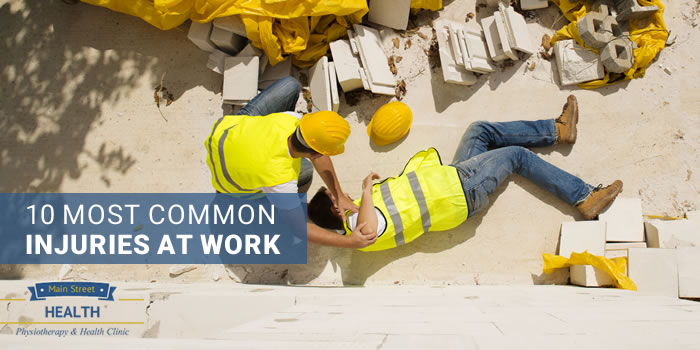Unless you work in explosives or other high-risk occupations, you probably don’t think much about workplace safety. Even if you’ve heard some statistics about on-the-job injuries, you likely assume something like that could never happen to you. You may be surprised to learn that, according to the Workplace Safety and Insurance Board (WSIB) claims for lost time, thousands of workers are injured on the job every year in the Services sector alone. Overall, the Services, Health Care, Manufacturing, Transportation, and Construction sectors made up close to 84% of all lost time claims in 2014. So, what are the 10 most common injuries at work?
No one is immune to injuries; but through increased awareness and better safety measures, fewer employees will need medical treatment for these 10 common, avoidable mishaps:
1. Overexertion Injuries
WSIB statistics reveal that overexertion injuries have been the leading injury across the 25-44 age group over the past 10 years, so this is a category that requires your undivided attention. When you become fatigued or exceed your body’s capacity for performing a physical task such as lifting, carrying, throwing, turning, pushing, holding or wielding heavy objects, you’re putting yourself at risk for injury. Here are a few of the problems associated with overexertion:
- Back pain (low back strain and back injury)
- Neck pain (neck injury)
- Shoulder pain (rotator cuff syndrome)
- Elbow strain
- Muscle strain
- Leg and knee strain (knee sprain)
Immediate Treatment options used to reduce minor overexertion injury recovery times and time lost from work include: rest, ice, compression and elevation. The use of anti-inflammatory drugs, wrapping, and in severe cases, casting can also be used during the healing process. Seeking rehabilitation support even with minor overexertion injuries can assist in healing times and decrease incidence of reinjuring the same site. Chiropractic therapy and massage therapy can be used to treat muscle sprains and strains by manipulation of the affected area to reduce spasms. In addition, physiotherapy treatments are often recommended so you can learn exercises to eliminate low back pain and strengthen muscles, joints and ligaments to decrease overexertion type injuries.
2. Slipping, Tripping and Fall Injuries

The second most common cause of workplace injuries to the 25-44 age group and first among the 50-54 age group was as a result of slipping, tripping and falls. The majority of occurrences were due to a wet or slippery floor or a trip over debris on the floor. Reaction injuries are also included in this category where the worker doesn’t actually fall but has reported muscle strains or other trauma from “saving themselves” from falling. You may have experienced something similar if you slipped and caught yourself before falling. Specific injuries reported include:
- Leg and knee injuries (sprains, strains and fractures)
- Foot injuries (sprains, strains and fractures)
- Lower back pains/pulls.
- Shoulder and arm pain (dislocation, sprains and fractures)
- Head injury (concussion)
Treatment options for minor incidents are similar to overexertion injuries including using ice, heat, compression bandage, casting, ultrasound or electrical muscle stimulation. Even in minor incidents and definitely in more serious cases, engaging a rehabilitation specialists can increase speed of recovery. Chiropractor visits can often help to regain mobility; while physiotherapy can often assist patients through exercises and functional training to decrease or eliminate low back pain.
Prevention is the best way to reduce workplace slips and falls. Safety guidelines should be in place to promptly clean up spills and remove debris. Always be mindful of an unsafe environment – pick up papers dropped on the floor or report icy outdoor walkways to prevent accidents.
3. Elevated Falls
These injuries are more common in the Construction or Manufacturing sectors and are the result of falls from roofs, ladders, scaffolding and stairways. Incidents are often caused from slip and fall type accidents or as a result of faulty equipment. Specific injuries vary but are often more serious with reports of fractures, head injuries, lacerations and even death. Lost time claims for these incidents are typically much longer, often requiring hospitalization and months of rehabilitation time. Engagement of rehabilitation professionals early can decrease healing times and help facilitate return to function.
Occupational Health and Safety Act (OHSA) regulations have reduced the number of accidents by requiring the use of personal protection gear, guardrails, tethers and safety training. Be sure to follow safety guidelines for your particular job.
4. Falling Objects
The Construction and Manufacturing sectors account for the majority of falling object injuries. Objects falling from warehouse shelving or dropped from above at construction jobsites often result in serious head injuries. It’s critical that employers maintain clean work environments and reinforce safety training; while employees implement the use of protective gear such as hard hats and steel toe work boots. It’s advised that early engagement of rehabilitation professionals may help both healing and faster return to function.
5. Object Collisions
While it may seem logical not to walk into solid objects such as walls, windows, cabinets, doors, tables, chairs or other stationary items, injuries from these incidents are more common than you would think. Resulting injuries generally affect the head, neck, knee and foot. Always keep walkways clear, watch where you’re going and slow down. Claimants often report they were in a hurry and didn’t notice the object until it was too late.
6. Motor Vehicle Accidents

As you might imagine, WSIB statistics show that motor vehicle accident (MVA) injury claims are most common in the Transportation and Construction sectors. Truck, automobile and construction vehicle accidents have been reported with serious injuries and fatalities. While all body parts are susceptible, the most common motor vehicle injuries are:
- Connective tissue (whiplash, neck and back stiffness)
- Head trauma (concussion)
- Brain injury
- Back injury
- Spinal cord injury
- Neck injury
- Internal organ injury or bleeding
- Hip, knee, leg, ankle, foot injury
- Arm, elbow, wrist, shoulder injury
- Ribs, collarbone injury
- Cuts, bruises, lacerations and contusions
Many car accident injuries can be prevented through employee Safe Driver training programs and well-maintained vehicles. Always follow the rules of the road and wear a seatbelt. With the possibility of a long recovery period, it’s important to consult with rehabilitation professionals as soon as possible. Early intervention may speed healing and facilitate your return to work.
7. Machine Entanglement
The manufacturing industry is very susceptible to this type of injury where machinery and heavy equipment are used. Time lost injuries occur when clothing, fingers, hair, shoes and jewelry become entangled. Severe trauma, amputation and death have been reported. Always take precautions to wear protective or job-appropriate clothing, steel-toe shoes, remove jewelry, secure long hair in a net or with a hair tie, and always make sure equipment safety guards are kept in place.
8. Repetitive Motion
These injuries have received a tremendous amount of press over the last few years as they have become more prevalent. Continued long-term exposure to typing, computer and mouse use can put excessive strain on muscles and tendons. Time loss injuries include back pain, tendonitis, Carpal Tunnel Syndrome, tennis elbow, eye strain and migraine headaches. Employers are encouraged to supply proper ergonomic equipment (chairs, workstations, wrist supports.) To reduce eye strain and headaches, follow the 20-20-20 rule: For every 20 minutes in front of a computer screen, look at something 20 feet away for at least 20 seconds. It’s also helpful to get up, walk around, stretch and drink water to reduce muscle stiffness and fatigue. Early identification of these types of injuries can assist in decreasing healing times. Occupational Therapist are able to redesigning work spaces and manner of working to decrease incidents or severity of symptoms.
9. Noise-Induced Hearing Loss
Ontario Manufacturing and Construction industry employees have claimed hearing loss from continuous, high-decibel factory or job site noise. While some injuries have occurred from isolated incidents, many suffer long-term or permanent hearing impairment. In January of 2007, OHSA introduced stricter noise exposure limits in the workplace to reduce noise-induced hearing loss for workers. Regulations reduced a worker’s daily noise exposure from 90 dBA to 85 dBA over an 8-hour time period. It’s important to also use protective hearing devices (earmuffs and earplugs) to reduce your exposure and retain your hearing.
10. Workplace Violence
Unfortunately, workplace violence is a growing concern across Ontario and the world. Attacks on co-workers and management by disgruntled employees can be caused from disagreements and arguments on a wide variety of subjects such as office politics, company policy, workplace romance, cultural differences or mental illness. Serious physical injuries and deaths have been reported. Employee training and attentiveness in watching for suspicious activities can help prevent more workplace violence.
While training, diligence and proper safety equipment have all helped reduce the number of workplace accidents and injuries over the last 10 years, it’s vital that you take responsibility for your own well-being on the job. Be alert, stay focused and speak up if you notice anything that is unsafe. Prevention is key to workplace safety across all industry sectors, age groups and genders. It only takes one person to make a difference.




